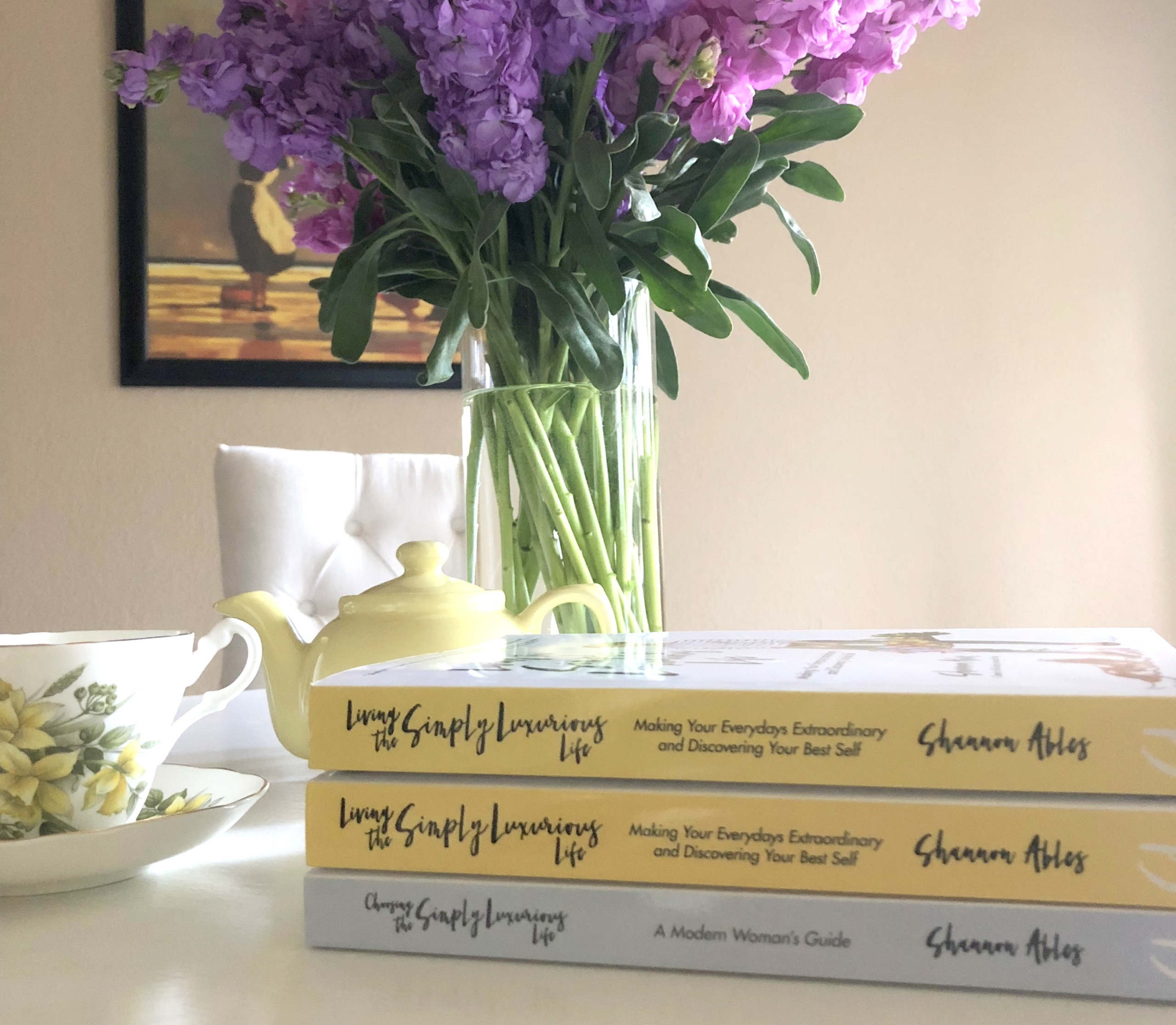Become a Member for as little as $4/mo and enjoy unlimited reading of TSLL blog.

In just four years time, the self-publishing world has exploded. With more recognition from readers to news organizations and publicists, self-publishers have demonstrated they can be taken seriously as well if their product is top quality.
The challenge any writer takes on when choosing to self-publish is to invest in their idea. In other words, betting on something that is not guaranteed.
In 2014 my first self-published book Choosing The Simply Luxurious Life: A Modern Woman’s Guide was released and while I did my homework, listened to those who had gone before me and followed the 11 steps I outline below, I wasn’t sure how it would all work out. As well as publishing a paperback copy, I also published an eBook and two years later an audio book with Audible. Within the first year, 10,000 copies were sold, and for that I thank my TSLL readers for not only reading the book, but sharing the book with their friends and families and leaving their positive reviews of what they loved on Amazon so that new readers could discover what simply luxurious living was all about.
As promised, as today I announce the preordering of my second book Living The Simply Luxurious Life: Making Your Everydays Extraordinary and Discovering Your Best Self, I wanted to share my experience with self-publishing and what has worked for me.
1. Write about a topic you are passionate about (non-fiction or fiction)
In 2014, Smashwords (an eBook self-publishing distributor) reported that its catalog offered over 250,000 titles from over 70,000 authors and publishers. That was four years ago when self-publishing was garnering 31% of the book market. That percentage has moved into the 40% numbers as of early 2018, so there are oodles of self-published topics that have been covered. The key is to write about something you not only love, but are willing to explore in-depth.
The length of this process will depend upon your time schedule and the concept of your book. Regardless, dive in, become comfortable in your own company and let yourself enjoy the creative process. Keep a notebook with you at all times (I always have my Moleskine with me) to capture ideas when they present themselves (they will leave on a moment’s notice), and even when it doesn’t make sense initially, follow where your curiosity leads you.
2. Find and hire a professional editor
(not your friend who is an English major unless they have an impressive editing resume)
Even as someone with a Bachelor of Arts with a major in English, I still would not edit my own writing. And when it comes to editing a book for publication purposes, having an expert, someone who knows the editing dos and don’ts like the back of their hand is a gift from the gods.
Choose an editor that is selective about who they work with. My editor, who has worked with me on both of my books (and I look forward to working with her on my third – yes, the ideas are already percolating!), was recommended to me by another author. Even then, I had to submit my work to the potential editor for her determine if she wanted to work with me. Then I asked to see other books she had edited. It was a process of both of us vetting each other. But the rest is history.
Investing in an awesomely talented editor will be the most expensive part of the self-publishing process, but it will be the best investment you can make. Why?
- Organization – you may have great ideas, but how do you arrange them (especially in a non-fiction book) to make sense for the reader? That is what your editor will help you do.
- Adhere to publishing editing standards – will help you with syntax to diction and everything in between.
- Formatting – will lay out the manuscript according to publishing expectations to ensure your book is a professional product that readers will enjoy reading with their eyes and their minds.
- Be objective – will tell you what needs to be cut even if you cannot see it yourself (you won’t, it’s impossible to be objective about our own work).
3. Edit – slowly, repeatedly, beyond what feels necessary
While I do work full-time as a high school teacher, my editing for each of my books, which were between 336-400 pages, took 7-8 months each to edit. Keep in mind I spent each weekend for 7-8 months editing back and forth with my editor and did not spend any time during the workweek as I had to teach but also to write my 5-6 blog posts for TSLL.
The amoutn of time spent editing will depend upon the length of the book and the time you can dedicate to it fully. Do not rush this process.
Once you are done editing with your editor, get a fresh pair of eyes (or two or three) to read the copy for things you and your editor may have missed. Again, after you have read chapter one for the tenth time, it will be almost impossible to catch the simple missing word that your mind thinks is present, but your eyes actually do not.
4. Find a self-publishing distributor
Check out Createspace.com(Amazon’s self-publishing company) and there are others – Intagram Spark, Book Baby, Lulu, etc.). Each of these distributors breaks everything down (price, who they distribute to, types of book print styles, etc.) differently, so check to see what aligns with the vision for your book.
No matter where you choose to self-publish you will need/be able to do the following:
- Purchase an ISBN – approximately $99/each or you can buy a bundle
- Maintain your publishing/copyrights
- Choose the best categories
- Distribute to multiple channels
5. Purchase a template
Createspace offers their own in-house template for each of the sizes of their books (there are many to choose from). You can also purchase a template from many different websites online. I purchased mine through Book Design Templates four years ago and returned to them for my second book. The cost is minimal and a one time fee, and it is in alignment with Createspace standards for uploading to their site. While they do have on-site help, four years ago it was easy to receive a quick response; however, this year it took far longer for a response. I attribute this to the growing industry of self-publishing. Understanding how to format in Word yourself if a huge benefit and money saver.
6. Once editing is complete, transfer your book’s manuscript to the template
As eager as you will be to transfer your book from manuscript to template form, wait until ALL of the editing is complete. I made this mistake as I became quite excited to see my book in the format it would print in, only to have to redo it as the editing was not complete. The transferring should be as easy as copy and paste, but you will want to check with your template to be sure.
7. Hire a graphic designer to layout your cover (front and back)
While for my first book I laid out my cover myself (just recently I updated the 1st book cover to be similar to my 2nd) with the help of my editor who has been in the publishing industry for decades, for my 2nd book I hired my web design team – Dash Creative – to lay it out to ensure the proper spacing, similar text to my blog and the exact color of yellow that I had envisioned for the spine. There are many people available to help with cover designs. Search the web, check out their portfolios and get a quote before making any decisions. The cover is an important decision, but it doesn’t have to be costly.
As far as the template for the cover, Createspace offers free downloadable templates. Simply input the length of your book (thus you will have to wait until you know the final length in pages – be patient), the size of the book and they will give you a file to download in which you would place your cover.
8. Upload in multiple mediums – paperback, eBook (smashwords, KDP, etc.) and audio
Once you are happy with the layout of your book, upload the interior copy and the exterior copy. They will let you approve it or redo it as many times as you need until you are happy (one of the details I love about self-publishing is that I can edit up to the day of the book’s release, and in fact, I can update after its release as well, as it is on-demand-publishing).
As well as paperback, be sure to publish to eBook format, and if you have a recording studio of some sort (or want to hire someone to read and record your book – audible makes it simple), make available an audio version.
9. (Optional) Hire a publicist for a specified period of time
Depending upon your online presence or public recognition due to your business, you may want to consider investing in a publicist. A publicist can be hired for a set amount of time (1 month, 3 months or 6 months). While their results are not guaranteed, once they give you a proposal of their plan, you can see if it would benefit your business or help you attain your goals. I did not hire a publicist for my first book and scheduled my book signings in New Orleans, New Canaan, and Oregon myself. However, I am considering hiring a publicist for a short duration to help make the connections that would not only save me time but also introduce me to audiences who might be interested in my book’s subject that I just don’t know about yet.
10. Send out ARC to bloggers/podcasters with cross-over audiences
ANNOUNCEMENT: I am excited to send out Advanced Review Copies to fellow bloggers and podcasters and other authors. If you are any of these three and feel you have a cross-over audience that would be interested in Living The Simply Luxurious Life: Make Your Everydays Extraordinary and Discovering Your Best Self, please email me at info@thesimplyluxuriouslife.com along with a link to your blog/podcast/website. I would be happy to send you a copy to review and share.
11. Set up a preorder opportunity if available (audio and eBooks – yes!; paperback – kind of)
Again, the self-publishing world has shifted tremendously in just the past four years. Previously you couldn’t set up preordering for ebooks, but now you can (Createspace makes it possible 3 months out, Smashwords – unlimited). However, Createspace still does not enable you to set a preordering option for self-published paperback books (there are some work-arounds, but they are a pain). As you can see here, you can set up preordering on your own if you have your own website/blog. The key is to spread the word as readers are busy and time is valuable. Let them know what they will be receiving, show or offer previews or excerpts (an excerpt of my new book will be shared on episode #214 of The Simple Sophisticate podcast – the Ask Shannon episode – Monday June 25th) and possibly make a trailer of the book’s contents to demonstrate what was your inspiration, specifically what will be addressed, etc.
Self-publishing is not for everyone, but as someone who wanted design control (I wanted to make sure Inslee’s illustrations could be on my cover each time I had the inspiration for a book and so that it would align with my blog), and is comfortable making the financial investment upfront, there is great peace of mind knowing that you can publish on your terms.
I would argue that self-publishing is a bit of a misnomer. As you probably noticed throughout the list above, I would not have been able to produce a quality book that I was proud of completely on my own. It takes a village of experts in their own fields, people who believe in your product and people who enjoy working together. I am deeply appreciative for the continued talent and patience my editor and my web designers afford me. Without them and so many others along the way, the books would not be what readers hold, and will soon hold, in their hands.
~Have a look at TSLL’s 2nd Book Preorder Launch here




Shannon, I am so excited about the new book! Order placed including a second copy of the first one.
Congratulations on the new book! Enjoy this beautiful journey that you so deserve.
But most importantly, thank you for sharing your passion for living the simply luxurious life that each of us are entitled to live.
Your Texas friend
Michelle
Michelle, thank you tremendously. Your continued interest and time or the years means so much. 🙂
Great information on self publishing. Thanks
My pleasure. I am always learning something new and applying as I move forward with my next book. 🙂
So enjoy reading your posts, and am particularly intrigued by this one. Can you provide any additional information about finding an editor, please? As a newly retired educator, I am considering all possibilities. Thank you so much!
There are a variety of options, but as always the key is compatibility and level of expertise. Referrals are wonderful. I was referred to my editor by a fellow author that I respect. You can check on Upwork as well as there are endless freelancers in a variety of fields.
Thank you so much!